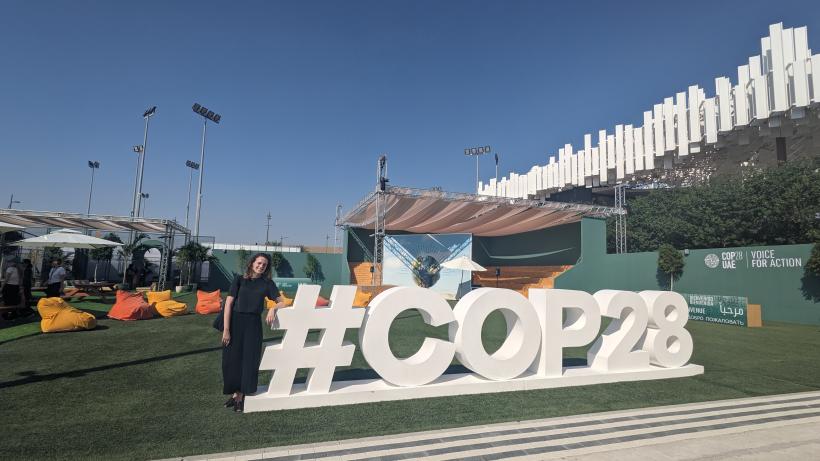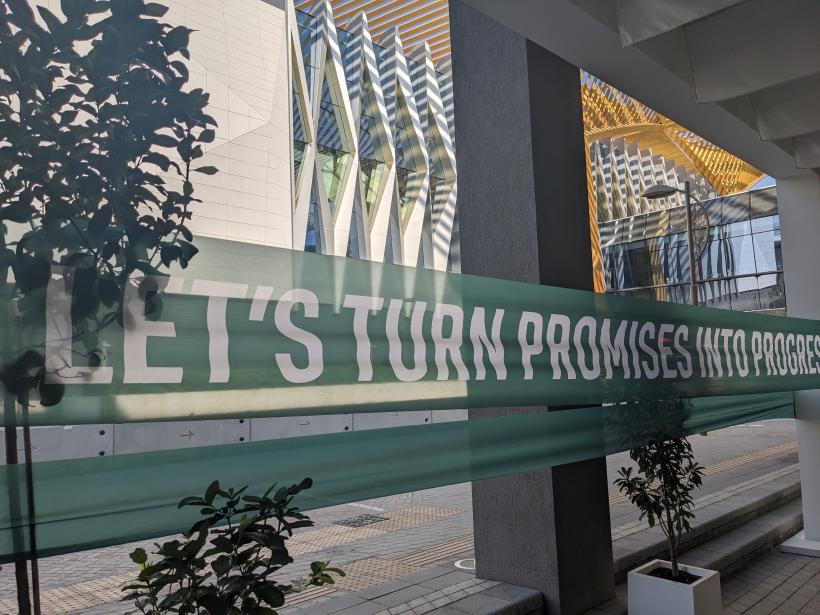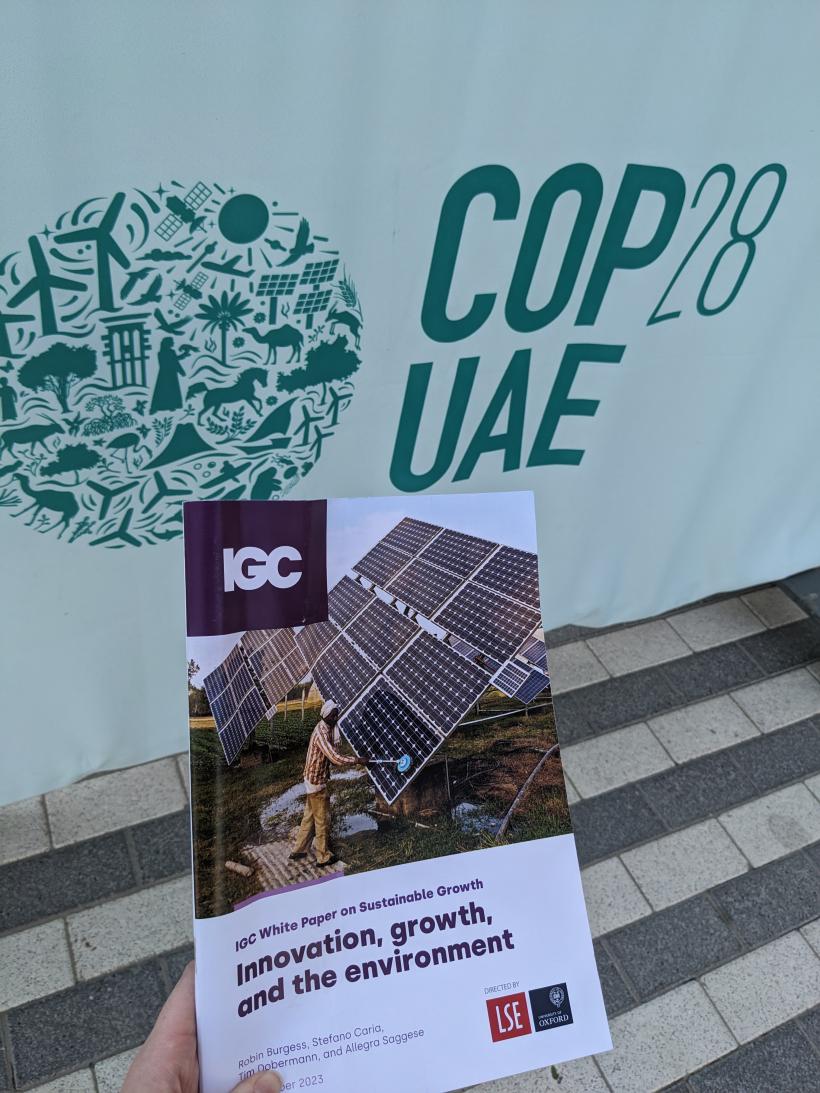
IGC’s Head of Communications reflects on COP28
COP28 was a pivotal moment in global commitments to address climate change, but there is still progress to be made to ensure developing countries are not left behind.
COP28 came to a close on 13 December 2023, but the scale of the event and the climate change challenges we face have since stuck with me.
This was my first time at COP. I was one of 85,000 at the biggest climate conference in history (compared to just under 40,000 at Glasgow in 2021 and only 4,000 at the first conference in 1995), during the hottest year on record.
There were many other firsts that defined the event too:
- Global Stocktake (GST): The first GST concluded at COP28, after more than 1,000 submissions were debated by governments, research institutions, and international organisations, amongst others, to assess progress on climate change;
- Inclusivity: COP28 aimed to be the most inclusive COP ever, hosting for the first time a G-77 summit, made up of a coalition of 134 developing countries;
- Urbanisation: The inaugural Local Climate Action Summit committed just under USD$ 500 million to urban climate action;
- Multilateral Development Bank Reform (MDB): The launch of a Global Climate Finance Framework included the first ever common principles for evaluating nature-positive finance, and suggestions on MDB reform;
- Fossil fuels: Nearly every country in the world, some of which are oil states, agreed to “transition away from fossil fuels in energy systems, in a just, orderly and equitable manner, with developed countries continuing to take the lead.”
There is much to celebrate: the climate conversation is bigger than ever, and we have never had so much knowledge at our disposal to help set the climate change agenda.
But not everyone feels the same. The UAE Consensus has been met with a mixed reception.
For some, it is a landmark text that signals the beginning of the end of the fossil fuel era.
For others, it does not go far enough in acknowledging the level of financial support developing countries need to transition to renewable energy, which often requires a lot more investment up-front than other technologies, including across skills development and other areas of innovation. Many developing countries face a lack of access to finance for this and are also driven by economic development policy that prioritises alleviating poverty, creating jobs and fostering competitiveness.
As national policies are being developed in response to COP, there is an opportunity to consider how both economic and climate policy can help ensure COP28’s climate ambitions benefit everyone.
Taking stock
There was an urgency to 2023’s climate change negotiations. We are now over halfway to 2030, the target year for the Sustainable Development Goals (SDGs) and Paris Agreement, but reports released in the run-up to COP28 showed that the world is off track.
The UN’s “Sustainable Development Goals Report” highlighted that progress has been “weak and insufficient”, “stalled”, or has “gone into reverse” on 80% of targets. The COP28 GST “synthesis report” and “technical report”, emphasised that we are not reducing emissions quickly enough, are not sufficiently prepared to respond to climate hazards, and that more support needs to be mobilised from high-income countries to low- and middle-income countries.
Progress on funding and commitments
These findings set the scene for COP discussions, and the conference had a promising start, with the needs of developing countries featuring high on the agenda.
On the first day, over US$ 700 million of commitments were made as part of an agreement to operationalise the Loss and Damage Fund, which the World Bank has been invited to administer. The Fund establishes a legal obligation for high-income countries to help compensate countries most vulnerable to climate change damages.
Around US$ 3.5 billion was also pledged to the world’s largest climate fund, the Green Climate Fund, bringing its total to US$ 12.8 billion from 31 countries in its second round. With this, the Fund will be able to provide financial resources to developing countries to tackle climate change impacts and protect the most vulnerable populations, over the next four years.
On day two, the UAE Presidency launched the UAE Leaders’ Declaration on a Global Climate Financing Framework, which included suggestions around “[b]uilding better, bigger, and more effective MDBs”.
Three days in, over 130 countries signed the Global Renewables and Energy Efficiency Pledge, which aims to accelerate the world’s transition to clean energy by tripling renewable energy generation capacity to minimum 11,000GW, and doubling energy efficiency rates by 2030.
At the same time, the Climate, Relief, Recovery, and Peace Declaration was launched, calling for “...bolder collection action to build climate resilience at the scale and speed required in highly vulnerable countries and communities, particularly those threatened or affected by fragility or conflict, or facing severe humanitarian needs, many of which are Least Developed Countries and Small Island Developing States.” And US$ 500 million was announced in climate finance for urban infrastructure.

The walk to COP28 at Dubai's Expo 2020 site (Image via Annelise Andersen).
Some way to go
While this signalled progress, some saw these commitments as lacking.
For example, the US$ 700 million for the Loss and Damage Fund is far from the amount that is needed by countries already facing climate change impacts. As this IGC blog shows, the commitment made at COP15 for high-income countries to mobilise US$ 100 billion per year by 2020 to address the climate action needs of developing countries, has not been met and high-income countries owe an estimated US$ 192 trillion in order to meet climate targets by 2050. Even though the final COP text may acknowledge “deep regret” over the fact that this commitment was not met, it does not indicate how the remaining funds can be recovered.
During negotiations, some developing countries, including Small Island States, also raised concerns over the Fund’s administration by the World Bank, rather than as an independent entity. Developing countries had demanded in November 2023 that 11 conditions be put in place for the World Bank as host for them to agree to the proposal and retain some autonomy over the Fund. Whether the World Bank accepts these or not remains to be seen.
The future of fossil fuels
The debate about the future of fossil fuels, a thorny but crucial issue, also hung in the air.
The initial GST draft included three options around fossil fuels, ranging from committing to “an orderly and just phase out of fossil fuels” to containing no text at all.
The draft shared on the penultimate day of COP28 removed wording around phase-out or phase-down of fossil fuels and softened language across adaptation and in some areas of finance. While the text still underscored the importance of decreasing the consumption and production of fossil fuels, Small Island States, the African Group and some major economies including the US and in the EU, criticised it for not containing stronger language around fossil fuels.
The final text was released with, for the first time, an agreement to “transition away from fossil fuels” and towards increased adoption of renewable energy. While many have heralded this as historic, others, including those from developing countries, have remained deeply frustrated at the lack of commitment to “phase-out” fossil fuels in the agreement and questioned its levels of inclusion.
In response to the final text, Samoa’s representative Anne Rasmussen, the Lead Negotiator speaking on behalf of the Alliance of Small Island States, stated that “small-island states were not in the room” when the agreement was made, and that avoiding climate crisis “has not yet been secured.”
Some noted the lack of new financial commitments to support developing countries during the transition. Senegal’s Climate Minister and Chair of the Least Developed Countries Group, Madeleine Diouf, pointed to the “vast gap between developing country needs and the finance available.”
Next steps
The coming months will be essential for climate action. Nations will already be looking to revise their Nationally Determined Contributions post-COP28, which will be presented between 2024 and 2025, ahead of COP30.
Ahead of COP29, there is already discussion around how the New Collective Qualitative Goal, a new financial goal, can replace the US$ 100 billion commitment made in 2009 with the US$ 5.8 - 5.9 trillion that developing countries need up until 2030. As we get closer to the next COP, it will be important to continue discussing how to secure resources for developing countries for a transition to clean energy.
A future where we can foster inclusive economic growth and tackle poverty in developing countries while protecting the natural environment is both possible and essential, as the International Growth Centre’s recently launched white paper on sustainable growth, Innovation, growth, and the environment outlines.
Economic research can play a valuable part in assessing the effectiveness of climate change policies, to help ensure they are economically viable and equitable, drive informed decisions on investments and include everyone.

The International Growth Centre's white paper on sustainable growth (Image via Annelise Andersen).

